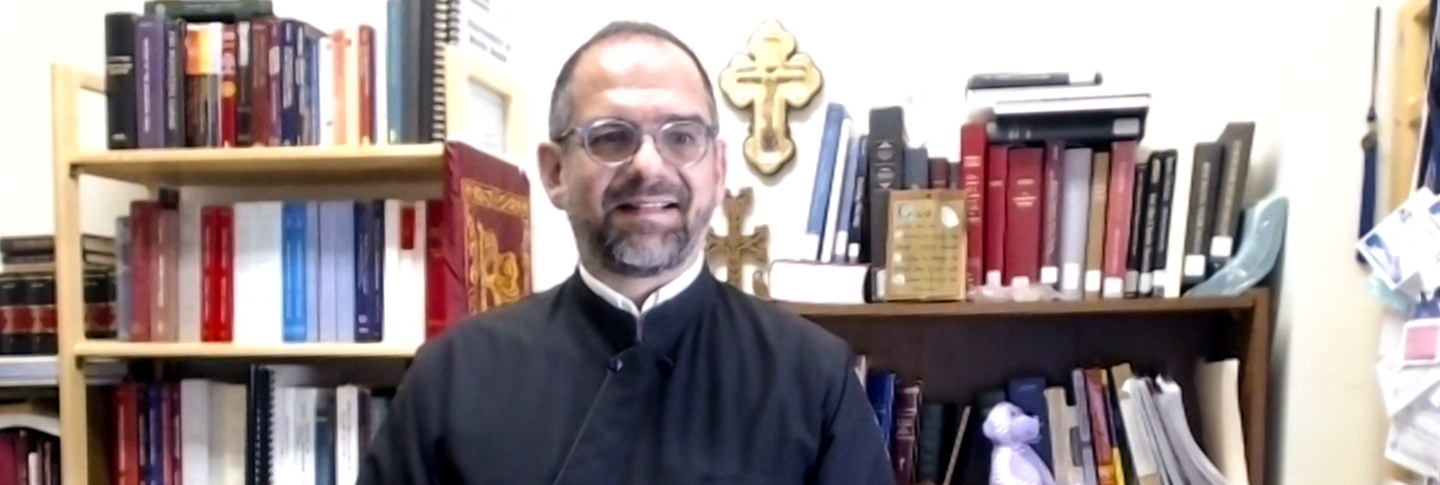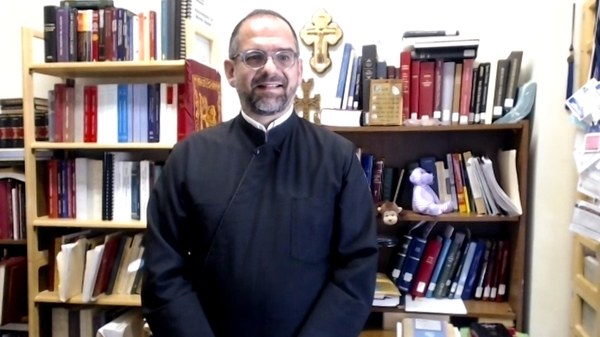Stefanos Alexopoulos, associate professor of liturgical studies and sacramental theology at the Catholic University of America, is a 2020–2021 fellow in Byzantine Studies. His research report, “Popular Piety and Official Liturgy in Byzantium: The Office of Holy Communion,” explored the origins and evolution of the Office of Holy Communion in popular and official practice.
Q&A with Stefanos Alexopoulos
What is the Office of Holy Communion and its role in the Byzantine church?
Holy Communion is the reception of consecrated bread and wine during the Divine Liturgy, what the Roman Catholic Church calls Mass. Central to the Divine Liturgy is the offering of bread and wine, which are considered by the faithful to be consecrated into the body and blood of Christ through the eucharistic prayer offered over these gifts. The gifts themselves—the consecrated bread and wine—and the act of partaking in them are both called Holy Communion.
The Office of Holy Communion now is a series of private prayers that I think reflects the piety of the faithful in this central action of the Divine Liturgy. These private prayers grew out of the understanding that Christians need to prepare to receive the gifts with the proper disposition and also to offer thanks to God for those gifts. Eventually, the prayers came to be structured around three moments: prayers as you prepare to receive the gifts, prayers at their reception, and prayers of thanksgiving afterward. The prayers before receiving have a more penitential emphasis, acknowledging one’s sinfulness. Prayers during and after the reception emphasize thanks that in spite of sinfulness we are deemed worthy to receive, and we thank God for that gift.
What do we know about the history of the Office of Holy Communion from visual and textual sources, like the Dumbarton Oaks paten?
The roots of the Office of Holy Communion lie in the homiletical and catechetical tradition of the fourth to sixth century. In other words, sermons of bishops from the fourth to the sixth century gave people guidelines of how to approach the Eucharist or Holy Communion. These guidelines talked about both spiritual disposition and bodily posture, and during the sixth century, the guidelines grew and evolved into actual prayers. For example, I’ve been virtually consulting the Dumbarton Oaks paten, which depicts the reception of the Eucharist by the disciples of Christ from Christ himself. It offers a sense of the bodily postures of reverence while receiving the Eucharist, like bowing.
These random prayers were gradually brought together to create a structured sequence that today we call the Office of Communion. So the Office of Holy Communion is really an anthology of prayers, and eventually the printing press standardized the selection of prayers.
How do these prayers intersect with public worship?
I plan to study the tension between private prayers of Holy Communion and the official text of the Divine Liturgy. The former, a product of piety, places a huge emphasis on personal sinfulness and unworthiness. The latter, the official text reflecting the teaching of the Byzantine Church, highlights communal participation in the reality of salvation celebrated at the Divine Liturgy. According to the official text, in spite of our sinfulness we are privileged to receive the Eucharist since we are already participating in the kingdom of God.
I’m also looking at how these private and public prayers interact. Some private prayers have made their way into public liturgy, but the official prayers are most often recited silently, which means people cannot hear the prayers. We have evidence that by the sixth century, the official text of the liturgy was recited inaudibly by the celebrant (the priest) for a variety of reasons. As a result, faith formation occurs not by the official liturgical texts but by private prayers. That gives congregants the opportunity to do their own prayers while the official liturgy takes place, so there are parallel prayers: the celebrant saying the official liturgy, and each person praying simultaneously with his or her own prayers.
I think what is interesting about this study is that it bridges the scholarly study of Byzantine liturgy with the actual practice of Byzantine liturgy today, because the Byzantine tradition is a living tradition. And as a practitioner of that tradition myself, it’s interesting not just from a scholarly perspective but also from a practical, theological perspective.
May Wang is postgraduate writing and reporting fellow at Dumbarton Oaks. Photo by Richard Tong, postgraduate digital media fellow.

